Wednesday, March 17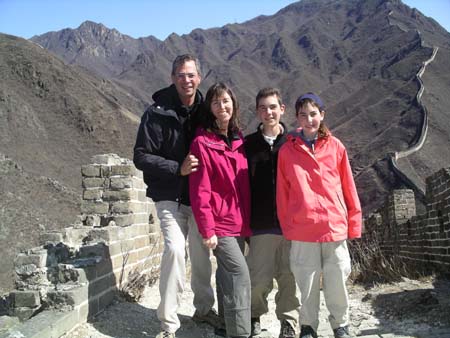
Paula and Steve: Today was one of the days we looked forward to since first deciding to go to Asia. It required a little persistence and effort but we finally "conquered" the Great Wall of China. The morning was clear, crisp and windy, so we piled on all the clothing we could and headed off.
When our guide picked us up at the hotel, he informed us that he heard on
the news last night that construction at the Huanghua section of the wall,
where we had specifically wanted to go, was starting today and therefore might
be closed. What bad luck… Then we started to wonder. Yesterday he questioned
us about why we wanted to go to 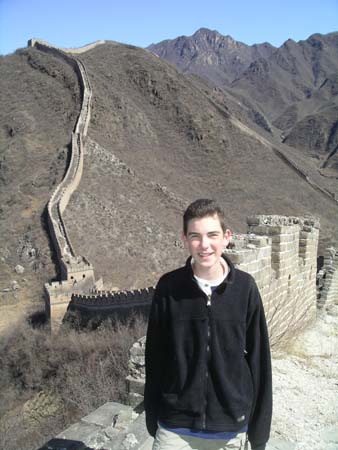 this
part of the wall at all. Didn't we want to go to Badaling, we had been asked,
which has been restored, is easier to get to and climb, and has facilities
available for tourists? Not sure exactly what was going on, we told our guide
that we'd like to take our chances and still try to see the Huanghua section.
What a good decision this turned out be…
this
part of the wall at all. Didn't we want to go to Badaling, we had been asked,
which has been restored, is easier to get to and climb, and has facilities
available for tourists? Not sure exactly what was going on, we told our guide
that we'd like to take our chances and still try to see the Huanghua section.
What a good decision this turned out be…
As we headed north from Beijing, we began to see the Yan Mountains in the
distance and found ourselves driving through villages, date trees, and farmland.
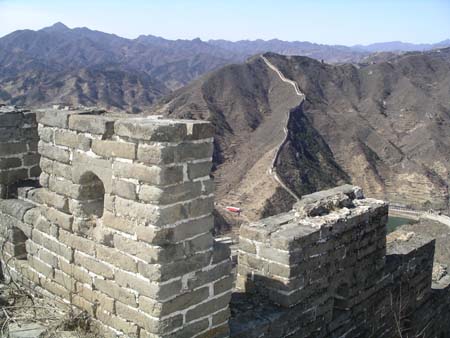 Most of the villages appeared deserted - our guide said that most of the people
were out working in their fields, but we didn't see much evidence of that.
Soon we were driving up through the mountains on a windy road with great views
that stretched for miles in today's clear air. We had no idea that this drive
would be so scenic - this was a very pleasant surprise.
Most of the villages appeared deserted - our guide said that most of the people
were out working in their fields, but we didn't see much evidence of that.
Soon we were driving up through the mountains on a windy road with great views
that stretched for miles in today's clear air. We had no idea that this drive
would be so scenic - this was a very pleasant surprise.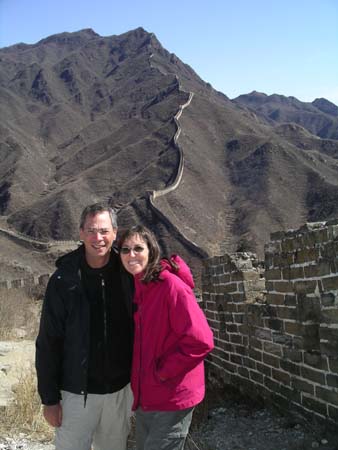
The Great Wall of China stretches over 1,500 miles from the east coast of
China to the Gobi Desert. The original wall was begun during the Qin dynasty
in 221 BC. Once separate walls around seven kingdoms, they were eventually
connected to protect against nomadic invaders from Mongolia. Our guide told
us that over a million workers constructed the wall including prisoners, criminals
and soldiers. The Huanghua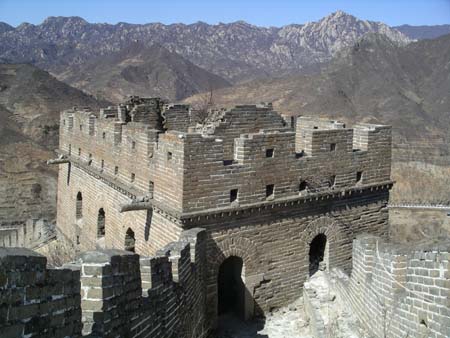 section of the wall that we decided to visit today was added later by the
Ming dynasty, making it about 600 years old. This area of the wall is 25-feet
high and generally 8-10 feet wide (at the top), and includes several sturdy
beacon towers of brick construction. The wall never turned into an effective
defensive structure - it was too easy for invading forces to destroy or climb
over, and there were too many gaps in the wall. It did however turn into a
useful way to move soldiers and equipment across the mountains. Various emperors
wrote that their defenses relied mainly on the courage of their soldiers,
and not on the wall.
section of the wall that we decided to visit today was added later by the
Ming dynasty, making it about 600 years old. This area of the wall is 25-feet
high and generally 8-10 feet wide (at the top), and includes several sturdy
beacon towers of brick construction. The wall never turned into an effective
defensive structure - it was too easy for invading forces to destroy or climb
over, and there were too many gaps in the wall. It did however turn into a
useful way to move soldiers and equipment across the mountains. Various emperors
wrote that their defenses relied mainly on the courage of their soldiers,
and not on the wall.
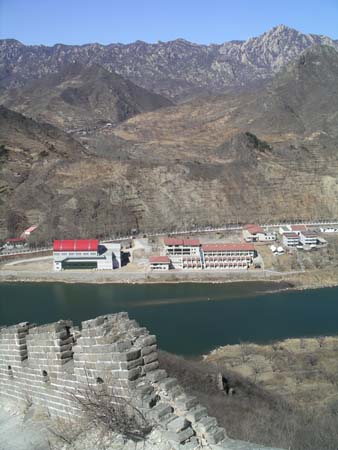 The
condition of the wall varies and has crumbled along many sections. But in
some stretches people can still trek for several days. In Badaling (70 km
north-west of Beijing), a small section of the wall has been totally reconstructed
for tourists and apparently other mountain villages and farmers are trying
to develop their own areas of the wall in an attempt to "relieve poverty"
and impress the party elite. Huanghua is clearly one of those areas - we saw
a large hotel (pictured here on the left) that has been built here but not
yet opened. Our guide told us that there are plans to possibly rebuild this
section of the wall and make it more accessible for tourists, but this has
not yet happened. This Unesco World Heritage Site is often called the world's
largest outdoor museum and because of its size, is difficult to protect. In
most areas, there are currently no laws or attempts to manage the site by
the government.
The
condition of the wall varies and has crumbled along many sections. But in
some stretches people can still trek for several days. In Badaling (70 km
north-west of Beijing), a small section of the wall has been totally reconstructed
for tourists and apparently other mountain villages and farmers are trying
to develop their own areas of the wall in an attempt to "relieve poverty"
and impress the party elite. Huanghua is clearly one of those areas - we saw
a large hotel (pictured here on the left) that has been built here but not
yet opened. Our guide told us that there are plans to possibly rebuild this
section of the wall and make it more accessible for tourists, but this has
not yet happened. This Unesco World Heritage Site is often called the world's
largest outdoor museum and because of its size, is difficult to protect. In
most areas, there are currently no laws or attempts to manage the site by
the government. 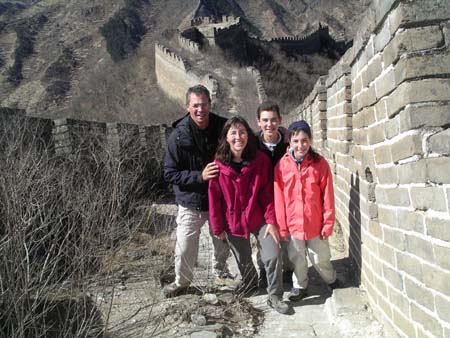
After just over an hour of driving, we got our first glimpse of the wall snaking its way across mountain ridges in the distance. Spectacular! We never expected the wall to wind up and down mountains this way - the sections we first saw traversed along extremely steep inclines. This gave us an immediate appreciation for how hard an undertaking its construction must have been.
We arrived at the Huanghua area, which was really no more than a few local
farmers selling souvenirs and nuts in front of a path that led over a dam
and up toward the wall. A sign had been painted on the rocks saying "This
part of the wall has not been restored - no clambering allowed." Uh-oh.
Our guide told us to stay put while he spoke with the people (again, these
were local farmers - certainly not officials associated with the wall or its
preservation). In less than a minute he returned saying that he had negotiated
a "special arrangement" for us. For 30 Yuan per person (that's about
$4), we would be allowed to pass. We were beginning to see how things work
here!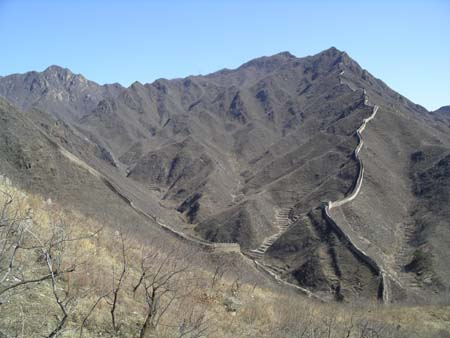
Our guide told us that in the eight years he's been guiding people, he's only been to this part of the wall once - and that was with his own friends! He again asked us how we heard about this, and we told him of the local friend-of-a-friend (Sarah, who we would meet later this evening) who had told us that this was the absolute best way to experience the wall.
We began our walk, climbing up the side of a small hill while fighting the
cold wind that had greeted us. Clearly, our guide was not enjoying himself.
He almost froze in shock as we crossed over the dam (it was easily a 6-foot
wide passage, but he seemed very scared of heights), and then quickly began
tiring as our climb started. In less than five minutes, we reached another
local farmer who told our guide that there would be a further fee required
for our passing. She explained that her family had personally constructed
the metal ladder that led up to the wall, and for that we needed to pay. Our
guide turned to us and said that he'd negotiate things with her, and that
we should 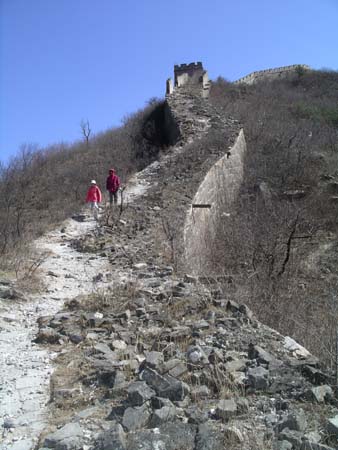 go
ahead - a very good excuse for him not to join us any further! His expectation
was clearly that we wouldn't last long on the walk. We quickly agreed with
his suggestion and climbed up the metal ladder to reach the top of the wall.
go
ahead - a very good excuse for him not to join us any further! His expectation
was clearly that we wouldn't last long on the walk. We quickly agreed with
his suggestion and climbed up the metal ladder to reach the top of the wall.
Our first steps on top of the wall were extremely exciting and memorable.
We were all alone (no other visitors anywhere in sight!) with fantastic sections
of the wall extending in both directions. We could see the wall winding up
and down mountains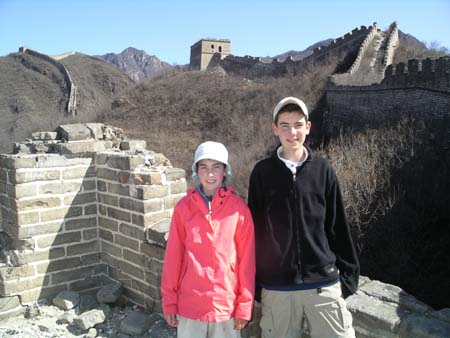 ,
finally disappearing far in the distance. It was absolutely spectacular!
,
finally disappearing far in the distance. It was absolutely spectacular!
The beauty of the Huanghua section of the wall is that it has never been restored. It was built 600 years ago, and the bricks and the "cement" (that we later learned was made from mixtures of rice and soil) are all original. There is a path, often steep, that traverses along the top of the wall and through the watchtowers that were built at equal intervals. As we walked, we marveled at the massive height and length of the wall, and tried to imagine what it had been like to build. We later learned that each inch of the wall represented a full day's work for a single laborer.
The beauty of our experience today is that we were absolutely alone on the
wall (except for two more local farmers that we'll describe in a moment).
It was just us and the fantastic scenery that extended in all directions.
As we climbed, the views just kept getting better, and we finally reached
a watchtower from where we had a wonderful perspective on how the wall weaves
its way through a long stretch of mountains and valleys. 
We encountered exactly two people on our walk today. The first was another local farmer, an older woman, who wanted to sell us nuts, firecrackers and postcards. When we declined politely, she started yelling at us in Chinese, and was clearly telling us that we couldn't pass without paying her two Yuan each for "tickets." It certainly wasn't worth arguing, so we handed her a 10-Yuan note. Instead of change, she handed us a bag of strawberries! This was clearly extortion, but we all got a good laugh out of things. We got revenge during our return walk when she tried to sell us more of her product (we imagined that she was going to ask us to pay for another "ticket") - instead we took pictures of her for our memories. She clearly wasn't happy with us snapping photos of her, but we had waited until we were out of distance before pulling out the camera. As we walked down, she screamed at us in Chinese and at one point we thought she was getting ready to make a run after us!
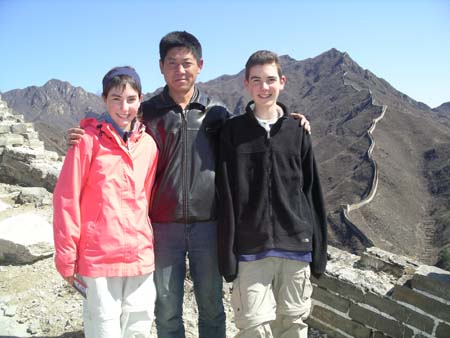 The
other person we met was much friendlier. He was sitting at the last watchtower
we reached, and offered to take family pictures of us. He spoke a bit of English,
and was genuinely interested in learning about us. We appreciated his kindness
so much that we simply handed him a 10-Yuan note, and he seemed overjoyed
(insisting that we take one of his packets of postcards). We then took a picture
of him with David and Katie, and he greatly enjoyed seeing the image of the
three of them together on our camera.
The
other person we met was much friendlier. He was sitting at the last watchtower
we reached, and offered to take family pictures of us. He spoke a bit of English,
and was genuinely interested in learning about us. We appreciated his kindness
so much that we simply handed him a 10-Yuan note, and he seemed overjoyed
(insisting that we take one of his packets of postcards). We then took a picture
of him with David and Katie, and he greatly enjoyed seeing the image of the
three of them together on our camera.
After about two hours, we returned to our van and learned that our guide
had been extremely worried about us. Why had we wanted to spend so much time
up there, and where did we go? He said that he even considered sending one
of the local farmers up to find us (for a fee, of course). We explained that
this had been a wonderful experience for us, and that the beauty of this area
is the fact that it hasn't been restored. We're not sure he understood, although
he said he did. By the way, we never did see any evidence of the construction
that our guide told us had been starting today! Hmmmmmmm…….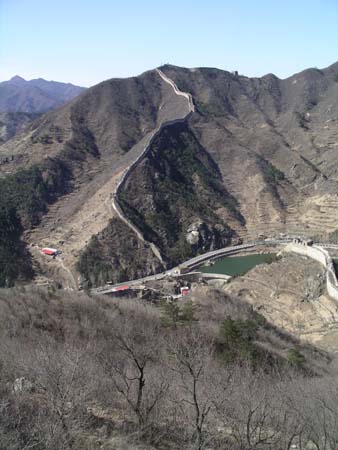
Our drive back today gave us an opportunity to speak with our guide more
about elements of life here in China. We first asked more about the events
of 1989. Our guide was fairly open with us, saying that he had actually been
a student at this time, and also had b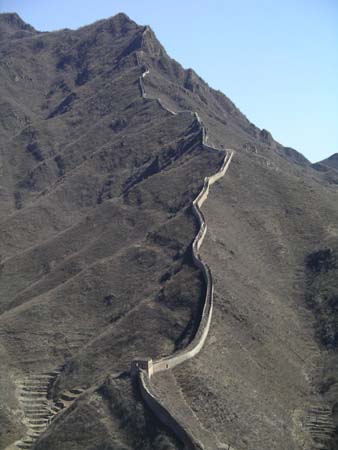 een
protesting in Tiananmen Square during the morning before the military force
began. Luckily for him, the students operated in "shifts", and he
had left the square during the afternoon. He described hearing the shooting
start, and said that it sounded like firecrackers - no one could believe that
the government forces had opened fire. He knew several students who had been
injured and imprisoned. He said that in the days following the military force,
there were many efforts made to track down any students who had been protesting.
Many of these people were punished. Our guide said that no information was
ever shared with the Chinese public regarding these events, and in his words
"you probably have more information than I do regarding the facts."
It was fascinating for us to hear about 1989 in Tiananmen Square from someone
who was actually a student here at the time.
een
protesting in Tiananmen Square during the morning before the military force
began. Luckily for him, the students operated in "shifts", and he
had left the square during the afternoon. He described hearing the shooting
start, and said that it sounded like firecrackers - no one could believe that
the government forces had opened fire. He knew several students who had been
injured and imprisoned. He said that in the days following the military force,
there were many efforts made to track down any students who had been protesting.
Many of these people were punished. Our guide said that no information was
ever shared with the Chinese public regarding these events, and in his words
"you probably have more information than I do regarding the facts."
It was fascinating for us to hear about 1989 in Tiananmen Square from someone
who was actually a student here at the time.
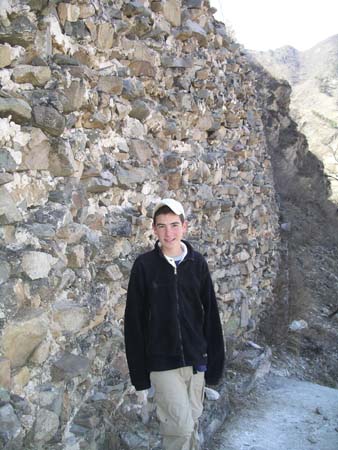
Another topic that we discussed was marriage, and learned that there are literally laws in place that forbid men from marrying before age 26 and women until they reach 24 (outside the big cities the minimum ages are 23 for men and 21 for women). These laws are another effort made by the government to help control population growth. We also discussed adoption, especially after seeing a bus full of European parents with their newly-adopted Chinese babies. We learned that often these babies are girls since most families want their single child to be a boy (to help on the farm). Tragically, some families resort to abortion or killing their own newborns when they find out their child is a girl.
We forgot to include our visit to Chairman Mao's mausoleum in yesterday's journal. Mao's mausoleum was similar to what we saw in Hanoi. People filed slowly passed his body, and no one spoke even as we waited in the 20-minute line outside. There were several soldiers present, but the rules weren't quite as strict as in Vietnam (e.g. we weren't forced to file two-abreast). Since we also visited Ho Chi Minh's mausoleum in Hanoi, we have now covered 2 of the big three Communists (unfortunately, we missed Lenin because Red Square was closed while we were there).
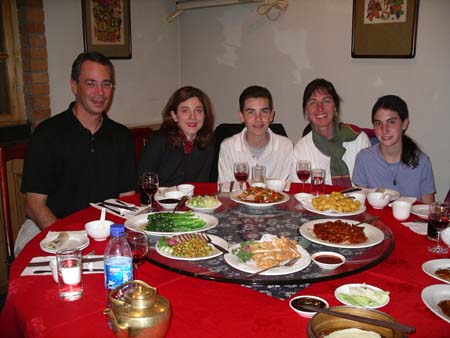
This evening we had a wonderful dinner of Peking Duck with Sarah, who is
the niece of a good friend from home. Sarah lives in Beijing and works as
a reporter. It was great getting to know her, and we enjoyed comparing travel
notes and discussing several aspects of life here in China. It's always valuable
to hear ex-pats talk about life in the countries that we visit, and gaining
new insight. For example, Sarah pointed out something that helped explain
an uncomfortable feeling we had in Tiananmen Square yesterday. What we didn't
explicitly realize at the time was the fact that although this is the largest
public 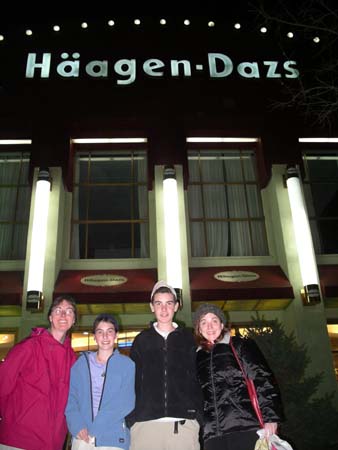 square
in the world, there are absolutely no benches or places to sit! This is because
the government doesn't want people hanging around the square - it's that sensitive
a place.
square
in the world, there are absolutely no benches or places to sit! This is because
the government doesn't want people hanging around the square - it's that sensitive
a place.
After dinner Sarah took us to an ultra-modern Haagen-Dazs, complete with sofas and shiny décor. The Chinese people eating there were all clearly from Beijing's upper-class, and we enjoyed a wonderful ice cream fondue dessert unlike anything we've seen at home. It was a fantastic end to the day, and we made plans to hook up with Sarah again tomorrow evening.
Tomorrow we are visiting the Hutong area of Beijing in the morning, and then will spend time at the Summer Palace before attending a Chinese opera in the evening. Another full day!
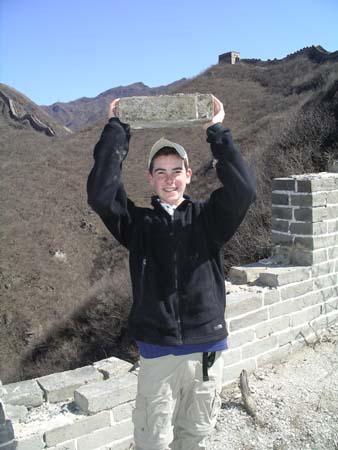
David's Daily Dump: The Great Wall of China. As I climbed into the
barren mountains atop the ancient Great Wall of China I was in a state of
disbelief, shock, and awe. Was I actually walking on the Great Wall of China?
The one I had seen on TV and learned so much about in school? I never thought
that I would ever have the chance to set my eyes on this wonder half way across
the world, let alone have it all to ourselves! Today was one of the most incredible
experiences I have had on this entire trip: walking on the Great Wall of China…
The thing that made our trip today phenomenal was the peacefulness of the wall. We walked on one of the only unreconstructed parts of the wall open to tourists. There was no one there, literally. We were all alone as we clambered up the crumbling masterpiece "ahhing" and "ooing" at the magnificent views. It was truly remarkable.
My favorite thing about the wall was how genuine and untouched it looked. Stones, bricks, and pieces of cement were scattered in every direction. Vegetation grew on either side of the barely visible path leading up the wall. I imagined myself as a Chinese soldier in the 3rd century B.C standing atop the wall shooting down at invading Mongols and protecting the empire. It was really cool. I also liked standing on top of the mountain peak and looking down at its snaking trial. It was mind boggling to think about how they built it with all those sharp turns and inclines. It was amazing!
I will never forget this fantastic day and hope to return to follow its trail once more.
